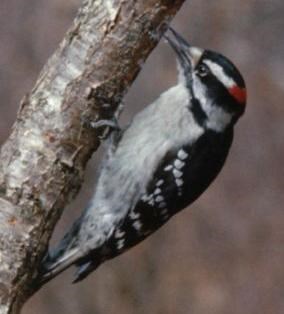
Hugh Crandall (NPS Photo) In most cases, visitors to our national parks are likely to relate visual experiences when asked what they recall about their visit. They describe what they saw. Often, however, our other senses of hearing, touching, and smelling can contribute to our park experience. Hearing the songs and calls of birds; hearing the rush of water cascading down waterfalls; or hearing the rustle of parched leaves of the fall in the wind all contribute to our experiences. These sounds are generally referred to as the soundscape. Soundscapes are important natural features of national parks. Besides contributing to the visitor experience they may be indicative of natural resource conditions. Wildlife may use particular sounds during courtship and mating or other behaviors which all make up the acoustic ecology of the area. Sudden sounds stem from trees or branches falling or when rock slides occur. Burning leaves and wood give off crackling and hissing sounds. Natural sounds may also be indicative of a given season. For instance, the songs and calls of birds may only be present during spring or fall migrations indicating their transient presence. The soundscapes of parks should be valued by visitors. Most visitors live in locations where they do not experience the sounds of natural settings. Instead, their soundscapes are dominated by the sounds of human activity - motor vehicle traffic, airplane traffic, sirens of emergency vehicles, construction equipment operation, and so forth. Even in park settings, these sounds are sometimes present. Park staff members here at Shenandoah are concerned about soundscapes particularly as they relate to wilderness experiences. By agency policy and legal requirements of the Wilderness Act, specific measures are taken to eliminate or greatly reduce the opportunity for visitors to encounter the sounds of motorized equipment while in the wilderness. Next time you are in Shenandoah, step away from You may be interested in reading about Unnatural Sounds and Noise (need to hot link this to the Profile titled Soundscapes/Noise) Shenandoah as well. Unnatural SoundsUnnatural sounds can simply be defined as those sounds that are produced by human activity or the operation of motors and equipment. Defining noise is not as simple. Clearly there are circumstances in which sounds exceed the capacity of the human ear to handle beyond which damage to hearing occurs - this would be considered noise. In other situations, however, noise may be present but no damages occur. Identifying noise is subject to human values and our capacity to become accustomed to background levels of noise. Within the context of park management, sounds that originate with people and that interfere with our ability to hear natural sounds (bird songs, blowing wind, cascading water, and so forth) are considered undesirable. In most cases, when noise is present in a park, it is considered a mild aggravation but in other cases that noise can disrupt the quality of a visitor's experience. Through the study of acoustic ecology, it has been determined noise also has the potential to alter wildlife behavior and is important to species survival. Noise can also detract from the portrayal of historical events and in some circumstances alter the physical condition of park resources. Examples of this last point, while not applicable to Shenandoah, are the triggering of avalanches or shocking of unstable ruins by sonic booms. The National Park Service has had limited, but longstanding interest in and concern with this topic. Historically this has most often been manifest in the regulation of noise in campgrounds (controlling operation of electrical generators or radios). Following passage of the Wilderness Act in 1964, under the direction of Congress, decisions started to be made to not allow the use of motorized equipment in designated wilderness areas; thus contributing to the wilderness experience of hikers and backpackers. Often this use of motorized equipment was in the form of chainsaws and various power tools by agency personnel. In more recent years, the perspective has broadened with greater emphasis on things like aircraft overflights, operation of jet skis, snowmachines, and ultralights, and neighboring industries that have processes that generate noise. Although staff members at Shenandoah National Park are not currently working on this topic, other parks elsewhere in the National Park System are. Related Information Useful references related to soundscapes are: Krause, B. 2002. Wild Soundscapes, Discovering the voice of the natural world. Wilderness Press, Berkeley , California .Krause, B.L. Wild Soundscapes in the National Parks: An Educational Program Guide to Listening and Recording. October 2002 Listen to the call of a Downy Woodpecker (USGS - PWRC) Library of Natural Sounds, Cornell University National Park Service Soundscape Website Websites related to noise in natural settings are: |
Last updated: February 3, 2020
